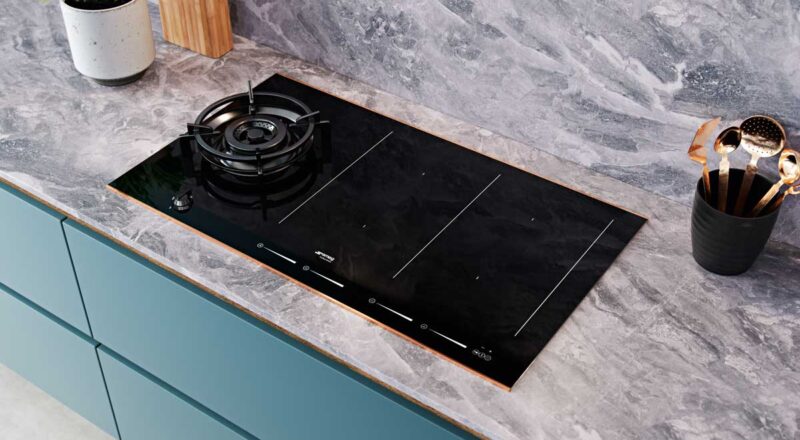In today’s modern kitchens, the question Can I use cast iron on an induction range? often arises. As more people switch to induction cooking, understanding how different cookware materials interact with this technology is crucial. If you’re considering using your beloved cast iron pans on an induction range, this article is for you.

Understanding Induction Cooking
Induction cooking is a method that uses electromagnetic fields to heat pots and pans directly. This differs from traditional cooking methods where heat is transferred from a flame or element to the cookware. Induction is known for its efficiency and precision.
How Induction Works
An induction range creates a magnetic field that induces electric currents in the cookware, producing heat. For this to work, the cookware must be ferromagnetic. This means it must contain iron or another magnetic material.
Benefits of Induction Cooking
Induction cooking is faster and more energy-efficient than other methods. It allows for quick temperature changes, making it easier to control cooking. Additionally, induction ranges often have a sleek, modern design and are easier to clean.
Why Cast Iron Works on Induction
Cast iron is a popular choice for induction cooking because it is naturally ferromagnetic. This means it can efficiently transfer the electromagnetic energy from the induction range into heat.
The Science Behind Cast Iron
Cast iron is composed primarily of iron, which is a key factor in its compatibility with induction ranges. Its dense structure allows it to retain heat well, providing consistent cooking results.
Durability and Heat Retention
One of the reasons cast iron is favored in kitchens is its durability. It can withstand high temperatures and is less likely to warp or become damaged. It also retains heat longer, making it ideal for slow cooking and searing.
Optimizing Cast Iron for Induction Cooking
To get the best results from your cast iron on an induction range, there are a few tips and tricks to consider.
Flat-Bottomed Cookware
Ensure your cast iron cookware has a flat bottom. This maximizes the contact area with the induction range, improving heat transfer.
Preheating Techniques
While induction heats quickly, preheating your cast iron can help achieve even cooking. Start at a low temperature and gradually increase it to avoid thermal shock.
Addressing Cold Spots
If you’ve experienced cold spots on your cast iron when using induction, it’s usually due to uneven contact. Ensure the cookware is flat, and consider rotating it occasionally during cooking.
Care and Maintenance of Cast Iron
Maintaining cast iron is essential to prolonging its life and ensuring optimal performance on an induction range.
Seasoning Your Cast Iron
Regularly seasoning your cast iron creates a non-stick surface and protects it from rust. This involves applying a thin layer of oil and heating it until it forms a hard, protective coating.
Cleaning Tips
After cooking, clean your cast iron with warm water and a soft brush. Avoid using soap. For stubborn residue, a paste of salt and water can be effective.
Common Issues with Cast Iron on Induction
While cast iron is suitable for induction, you may encounter some common issues. Understanding these can help you mitigate them.
Uneven Browning
Uneven browning can occur if the cookware doesn’t maintain consistent contact with the induction range. Ensuring a flat base can help.
Smoky Kitchens
If your cast iron becomes smoky during use, it might be due to oil burning. Use oils with a high smoke point, and avoid overheating.
Energy Efficiency
Using cast iron on induction is generally energy-efficient. However, if you’re concerned about energy usage, monitor your cooking times and temperatures.
Choosing the Right Induction Range
Not all induction ranges are created equal. Choosing the right one can enhance your cooking experience with cast iron.
Power and Settings
Look for an induction range with variable power settings. This allows for better control when cooking with cast iron.
Cooktop Design
A cooktop with a larger cooking zone can accommodate bigger cast iron pans, providing more even heat distribution.
Comparing Cast Iron to Other Cookware
While cast iron is excellent for induction, understanding how it compares to other materials can help you make informed choices.
Stainless Steel
Unlike cast iron, stainless steel heats quickly but doesn’t retain heat as well. It can be a versatile addition to your kitchen.
Copper and Aluminum
Copper and aluminum are not naturally magnetic, but some pots and pans have ferromagnetic bases, making them compatible with induction.
Environmental Impact
Induction cooking with cast iron is considered environmentally friendly due to its energy efficiency and durability, reducing waste from cookware replacement.
Longevity of Cast Iron
Cast iron can last for generations when cared for properly, minimizing the environmental impact of producing new cookware.
Final Thoughts on Cast Iron and Induction
Using cast iron on an induction range is not only possible but highly effective. With the right care and techniques, you can enjoy the benefits of both technologies in your kitchen.

FAQ
Can cast iron damage an induction cooktop?
No, as long as you handle it carefully. Avoid dragging it across the cooktop to prevent scratches.
Do I need special cast iron for induction?
No, any flat-bottomed cast iron should work well on induction ranges.
How do I know if my cookware is induction-compatible?
If a magnet sticks to the bottom of your cookware, it’s induction-compatible.
For more information on using cast iron with induction cooking, you can visit Lodge Cast Iron’s guide.
This article contains affiliate links. We may earn a commission at no extra cost to you.

